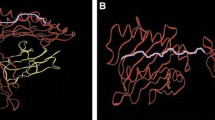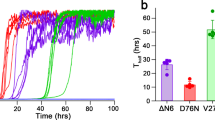Abstract
MHC class I molecules are heterotrimeric complexes composed of heavy chain, β2-microglobulin (β2m) and short peptide. This trimeric complex is generated in the endoplasmic reticulum (ER), where a peptide loading complex (PLC) facilitates transport from the cytosol and binding of the peptide to the preassembled ER resident heavy chain/β2m dimers. Association of mouse MHC class I heavy chain with β2m is characterized by allelic differences in the number and/or positions of amino acid interactions. It is unclear, however, whether all alleles follow common binding patterns with minimal contributions by allele-specific contacts, or whether essential contacts with β2m are different for each allele. While searching for the PLC binding site in the α3 domain of the mouse MHC class I molecule H-2Db, we unexpectedly discovered a site critical for binding mouse, but not human, β2m. Interestingly, amino acids in the corresponding region of another MHC class I heavy chain allele do not make contacts with the mouse β2m. Thus, there are allelic differences in the modes of binding of β2m to the heavy chain of MHC class I.






Similar content being viewed by others
References
Attaya M, Jameson S, Martinez CK, Hermel E, Aldrich C, Forman J, Fischer-Lindahl K, Bevan MJ, Monaco JJ (1992) Ham-2 corrects the class I antigen processing-defect in RMA-S cells. Nature 355:647–649
Carreno BM, Solheim JC, Harris M, Stroynowski I, Connolly JM, Hansen TH (1995) TAP associates with a unique class I conformation, whereas calnexin associates with multiple class I forms in mouse and man. J Immunol 155:4726–4733
Falk K, Rotzschke O, Stevanovic S, Jung G, Rammensee H-G (1991) Allele-specific motifs revealed by sequencing of self-peptides eluted from MHC molecules. Nature 351:290–296
Grandea AGI, Androlewic MJ, Athwal RS, Geraghty DE, Spies T (1995) Dependence of peptide binding by MHC class I molecules on their interaction with TAP. Science 270:105–108
Grandea AGI, Golovina TN, Hamilton SE, Sriram V, Spies T, Brutkiewicz RR, Harty JT, Eisenlohr LC, Van Kaer L (2000) Impaired assembly yet normal trafficking of MHC class I molecules in tapasin mutant mice. Immunity 13:213–222
Hansen T, Balendiran G, Solheim J, Ostrov D, Nathenson S (2000) Structural features of MHC class I molecules that might facilitate alternative pathways of presentation. Immunol Today 21:83–88
Harris MR, Lybarger L, Myers NB, Hilbert C, Solheim JC, Hansen TH, Yu YY (2001) Interactions of HLA-B27 with the peptide loading complex as revealed by heavy chain mutations. Int Immunol 13:1275–1282
Hughes EA, Cresswell P (1998) The thiol oxidoreductase ERp57 is a component of the MHC class I peptide-loading complex. Curr Biol 8:709–712
Kingsbury DJ, Mear JP, Witte DP, Taurog JD, Roopenian DC, Colbert RA (2000) Development of spontaneous arthritis in β2-microglobulin-deficient mice without expression of HLA-B27. Arthritis Rheum 43:2290–2296
Hughes E, Hammond C, Cresswell P (1997) Misfolded major histocompatibility complex class I heavy chains are translocated into the cytoplasm and degraded by the proteasome. Proc Natl Acad Sci USA 94:1896–1901
Koller BH, Marrack P, Kappler JW, Smithies O (1990) Normal development of mice deficient in β2M, MHC class I proteins, and CD8+ T cells. Science 248:1227–1230
Kulig K, Nandi D, Bacik I, Monaco JJ, Vukmanovic S (1998) Physical and functional association of the MHC class I heavy chain α3 domain with the transporter associated with antigen processing. J Exp Med 187:865–874
Lewis JW, Neisig A, Neefjes J, Elliott T (1996) Point mutations in the a2 domain of HLA-A2.1 define a functionally relevant interaction with TAP. Curr Biol 6:873–883
Li S, Sjogren H-O, Hellman U, Pettersson RF, Wang P (1997) Cloning and functional characterization of a subunit of the transporter associated with antigen processing. Proc Natl Acad Sci USA 94:8708–8713
Lindquist JA, Jensen ON, Mann M, Hammerling GJ (1998) ER-60, a chaperone with thiol-dependent reductase activity involved in MHC class I assembly. EMBO J 17:2186–2195
Ljunggren H-G, Stam NS, Ohlen C, Neefjes JJ, Hoglund P, Heemels M-T, Bastin J, Schumacher TNM, Townsend A, Karre K, Ploegh HL (1990) Empty MHC class I molecules come out in the cold. Nature 346:476–480
Ljunggren H-G, Van Kaer L, Ashton-Rickardt PG, Tonegawa S, Ploegh HL (1995a) Differential reactivity of residual CD8+ T lymphocytes in TAP1 and β2-microglubulin mutant mice. Eur J Immunol 25:174–178
Ljunggren H-G, Van Kaer L, Sabatine MS, Auchincloss Jr H, Tonegawa S, Ploegh HL (1995b) MHC class I expression and CD8+ T cell development in TAP1/β2-microglobulin double mutant mice. Int Immunol 7:975–984
Lopez de Castro JA (1998) The pathogenetic role of HLA-B27 in chronic arthritis. Curr Opin Immunol 10:59–66
Machold RP, Andree S, Van Kaer L, Ljunggren H-G, Ploegh HL (1995) Peptide influences the folding and intracellular transport of free major histocompatibility complex class I heavy chains. J Exp Med 181:1111–1122
Monaco JJ (1992) A molecular model of MHC class-I-restricted antigen processing. Immunol Today 13:173–179
Nandi D, Woodward E, Ginsburg DB, Monaco JJ (1997) Intermediates in the formation of mouse 20S proteasomes: Implications for the assembly of precursor β subunits. EMBO J 16:5363–5375
Neefjes JJ, Momburg F, Hammerling GJ (1993) Selective and ATP-dependent translocation of peptides by the MHC-encoded transporter. Science 261:769–771
Ortmann B, Androlewicz M, Cresswell P (1994) MHC class I/β2-microglobulin complexes associate with TAP transporters before peptide binding. Nature 368:864–867
Ortmann B, Copeman J, Lehner PJ, Sadasivan B, Herberg JA, Grandea AGI, Riddell SR, Tampe R, Spies T, Trowsdale J, Cresswell P (1997) A critical role for tapasin in the assembly and function of multimeric MHC class I-TAP complexes. Science 277:1306–1309
Pamer E, Cresswell P (1998) Mechanisms of MHC class I-restricted antigen processing. Annu Rev Immunol 16:323–358
Paquet ME, Williams DB (2002) Mutant MHC class I molecules define interactions between components of the peptide-loading complex. Int Immunol 14:347–358
Peace-Brewer AL, Tussey LG, Matsui M, Li G, Quinn DG, Frelinger JA (1996) A point mutation in HLA-A*0201 results in failure to bind the TAP complex and to present virus-derived peptides to CTL. Immunity 4:505–514
Rock KL, Rothstein L, Benacerraf B (1992) Analysis of the association of peptides of optimal length to class I molecules on the surface of cells. Proc Natl Acad Sci USA 89:8918–8922
Sadasivan B, Cariappa A, Waneck GL, Cresswell P (1995) Assembly, peptide loading, and transport of MHC class I in a calnexin-negative cell line. Cold Spring Harbor Symp Quant Biol 60:267–275
Sadasivan B, Lehner PJ, Ortmann B, Spies T, Cresswell P (1996) Roles of calreticulin and a novel glycoprotein, tapasin, in the interaction of MHC class I molecules with TAP. Immunity 5:103–114
Schumacher TNM, Heemels M-T, Neefjes JJ, Kast WM, Melief CJM, Ploegh HL (1990) Direct binding of peptide to empty MHC class I molecules on intact cells and in vitro. Cell 62:563–567
Scott JE, Dawson JR (1995) MHC class I expression and transport in a calnexin-deficient cell line. J Immunol 155:143–148
Shepherd JC, Schumacher TNM, Ashton-Rickardt PG, Imaeda S, Ploegh HL, Janeway CA, Tonegawa S (1993) TAP1-dependent peptide translocation in vitro is ATP-dependent and peptide selective. Cell 74:577–584
Spies T, Cerundolo V, Collona M, Cresswell P, Townsend A, DeMars R (1992) Presentation of viral antigen by MHC class I molecules is dependent on a putative peptide transporter heterodimer. Nature 355:644–646
Suh W-K, Cohen-Doyle MF, Fruh K, Wang K, Peterson PA, Williams DB (1994) Interaction of MHC class I molecules with the transporter associated with antigen processing. Science 264:1322–1326
Suh W-K, Mitchell EK, Yang Y, Peterson PA, Waneck GL, Williams DB (1996) MHC class I molecules form ternary complexes with calnexin and TAP and undergo peptide-regulated interaction with TAP via their extracellular domains. J Exp Med 184:337–348
Tector M, Salter RD (1995) Calnexin influences folding of human class I histocompatibility proteins but not their assembly with beta 2-microglobulin. J Biol Chem 270:19638–19642
Townsend A, Ohlen C, Bastin J, Ljungren H-G, Foster L, Karre K (1989) Association of class I major histocompatibility heavy and light chains induced by viral peptides. Nature 340:443–448
Uchanska-Ziegler B, Ziegler A (2003) Ankylosing spondilitis: a β2m-deposition disease? Trends Immunol 24:73–76
Van Bleek GM, Nathenson SG (1990) Isolation of an endogenously processed immunodominant viral peptide from the class I H-2 Kb molecule. Nature 348:213–216
Van Kaer L, Ashton-Rickardt PG, Ploegh HL, Tonegawa S (1992) TAP1 mutant mice are deficient in antigen presentation, surface class I molecules, and CD4−8+ T cells. Cell 71:1205
Van Leeuwen JEM, Kearse KP (1996) Deglucosilation of N-linked glycans is an important step in the dissociation of calreticulin-classI-TAP complexes. Proc Natl Acad Sci USA 93:13997–14001
Vasillakos A, Cohen-Doyle M, Peterson PA, Jackson MR, Williams DB (1996) The molecular chaperone calnexin facilitates folding and assembly of class I histocompatibility molecules. EMBO J 15:1495–1506
Vitiello A, Potter TA, Sherman LA (1990) The role of β2-microglobulin in peptide binding by class I molecules. Science 250:1423–1426
Vukmanovic S, Lilic M, Santori FR, Demaria S, Kulig K (2001) Peptide loading of nascent MHC class I molecules. Arch Immunol Ther Exp 49:195–201
Williams DB, Barber BH, Flavell RA, Allen H (1989) Role of β2-microglobulin in the intracellular transport and surface expression of murine class I histocompatibility molecules. J Immunol 142:2796–2806
York IA, Rock KL (1996) Antigen processing and presentation by the class I major histocompatibility complex. Annu Rev Immunol 14:369–396
Yu YY, Turnquist HR, Myers NB, Balendiran GK, Hansen TH, Solheim JC (1999) An extensive region of an MHC class I alpha2 domain loop influences interaction with the assembly complex. J Immunol 163:4427–4433
Zijlstra M, Bix M, Simister NE, Loring JM, Raulet DH, Jaenisch R (1990) β2-microglobulin deficient mice lack CD4−CD8+ cytolytic T cells. Nature 344:742–746
Acknowledgements
We thank John Hirst for FACS analysis and Ted Hansen for providing the anti-mouse β2m antibody. This work was supported by the NIH grants AI48837 and AI41573 to S.V., and NCI core support grant 5P30 CA16087.
Author information
Authors and Affiliations
Corresponding author
Rights and permissions
About this article
Cite this article
Lilić, M., Popmihajlov, Z., Monaco, J.J. et al. Association of β2-microglobulin with the α3 domain of H-2Db heavy chain. Immunogenetics 55, 740–747 (2004). https://doi.org/10.1007/s00251-003-0639-9
Received:
Revised:
Published:
Issue Date:
DOI: https://doi.org/10.1007/s00251-003-0639-9




